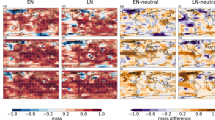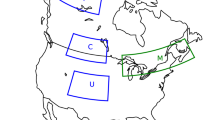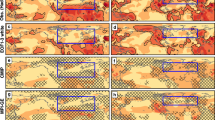Abstract
The question of how climate model projections have tracked the actual evolution of global mean surface air temperature is important in establishing the credibility of their projections. Some studies and the IPCC Fifth Assessment Report suggest that the recent 15-year period (1998–2012) provides evidence that models are overestimating current temperature evolution. Such comparisons are not evidence against model trends because they represent only one realization where the decadal natural variability component of the model climate is generally not in phase with observations. We present a more appropriate test of models where only those models with natural variability (represented by El Niño/Southern Oscillation) largely in phase with observations are selected from multi-model ensembles for comparison with observations. These tests show that climate models have provided good estimates of 15-year trends, including for recent periods and for Pacific spatial trend patterns.
This is a preview of subscription content, access via your institution
Access options
Subscribe to this journal
Receive 12 print issues and online access
$209.00 per year
only $17.42 per issue
Buy this article
- Purchase on Springer Link
- Instant access to full article PDF
Prices may be subject to local taxes which are calculated during checkout






Similar content being viewed by others
References
Bray, D. & von Storch, H. Prediction or projection: The nomenclature of climate science. Sci. Commun. 30, 534–543 (2009).
Peña, M. & Kalnay, E. Separating fast and slow modes in coupled chaotic systems. Nonlinear Proc. Geophys. 11, 319–327 (2004).
Yang, S-C., Keppenne, C., Rienecker, M. & Kalnay, E. Application of coupled bred vectors to seasonal-to-interannual forecasting and ocean data assimilation. J. Clim. 22, 2850–2870 (2009).
O’Kane, T., Matear, R., Chamberlain, M. & Oke, P. ENSO regimes and the late 1970s climate shift: The role of synoptic weather and south Pacific ocean spiciness. J. Comput. Phys. 271, 19–38 (2014).
Taylor, K., Stouffer, R. & Meehl, G. An overview of CMIP5 and the experiment design. Bull. Am. Meteorol. Soc. 93, 485–498 (2012).
Meehl, G. et al. Decadal prediction: Can it be skillful? Bull. Am. Meteorol. Soc. 90, 1467–1485 (2009).
Stocker, T. F. et al. in Climate Change 2013: The Physical Science Basis. Technical Summary (eds Stocker, T. F. et al.) (Cambridge Univ. Press, 2013).
Tollefson, J. The case of the missing heat. Nature 505, 276–278 (2014).
Lorenz, E. N. Climatic determinism. Meteorol. Monogr. 8, 1–3 (1968).
James, I. & James, P. Ultra-low-frequency variability in a simple atmospheric circulation model. Nature 342, 53–55 (1989).
O’Kane, T. et al. Decadal variability in an OGCM Southern Ocean: Intrinsic modes, forced modes and metastable states. Ocean Model. 69, 1–21 (2013).
Schneider, S. H. & Thompson, S. Atmospheric CO2 and climate: Importance of the transient response. J. Geophys. Res. 86, 3135–3147 (1981).
Meehl, G., Arblaster, J., Fasullo, J., Hu, A. & Trenberth, K. Model-based evidence of deep-ocean heat uptake during surface-temperature hiatus periods. Nature Clim. Change 1, 360–364 (2011).
Mantua, N. & Hare, S. The Pacific Decadal Oscillation. J. Oceanogr. 58, 35–44 (2002).
Foster, G. & Rahmstorf, S. Global temperature evolution 1979–2010. Environ. Res. Lett. 6, 1–8 (2011).
Fyfe, J., Gillett, N. & Zwiers, F. Overestimated global warming over the past 20 years. Nature Clim. Change 3, 767–769 (2013).
Cowtan, K. & Way, R. Coverage bias in the HadCRUT4 temperature series and its impact on recent temperature trends. Q. J. R. Meteorol. Soc. doi:10.1002/qj.2297 (2014).
Hansen, J., Ruedy, R., Sato, M. & Lo, K. Global surface temperature change. Rev. Geophys. 48, 1–29 (2010).
Toth, Z. & Kalnay, E. Ensemble forecasting at NCEP and the breeding method. Mon. Weath. Rev. 125, 3297–3319 (1997).
Meehl, G. et al. Decadal climate prediction: An update from the trenches. Bull. Am. Meteorol. Soc. 95, 243–267 (2014).
Kosaka, Y. & Xie, S-P. Recent global-warming hiatus tied to equatorial Pacific surface cooling. Nature 501, 403–407 (2013).
England, M. et al. Recent intensification of wind-driven circulation in the Pacific and the ongoing warming hiatus. Nature Clim. Change 4, 222–227 (2014).
Schmidt, G., Shindell, D. & Tsigaridis, K. Reconciling warming trends. Nature Geosci. 7, 158–160 (2014).
Trenberth, K. The definition of El Niño. Bull. Am. Meteorol. Soc. 78, 2771–2777 (1997).
Brown, J. N., Langlais, C. & Maes, C. Zonal structure and variability of the Western Pacific dynamic warm pool edge in CMIP5. Clim. Dynam. 42, 3061–3076 (2014).
Fyfe, J. & Gillett, N. Recent observed and simulated warming. Nature Clim. Change 4, 150–151 (2014).
Allen, R., Norris, J. & Wild, M. Evaluation of multidecadal variability in CMIP5 surface solar radiation and inferred underestimation of aerosol direct effects over Europe, China, Japan, and India. J. Geophys. Res. 118, 6311–6336 (2013).
Guilyardi, E. et al. Understanding El Niño in ocean–atmosphere general circulation models: Progress and challenges. Bull. Am. Meteorol. Soc. 90, 325–340 (2009).
Morice, C., Kennedy, J., Rayner, N. & Jones, P. Quantifying uncertainties in global and regional temperature change using an ensemble of observational estimates: The HadCRUT4 data set. J. Geophys. Res. 117, 1–22 (2012).
Moss, R. et al. The next generation of scenarios for climate change research and assessment. Nature 463, 747–756 (2010).
Rayner, N. et al. Global analyses of sea surface temperature, sea ice, and night marine air temperature since the late nineteenth century. J. Geophys. Res. 108, 4407–4444 (2003).
Kirtman, B. et al. in Climate Change 2013: The Physical Science Basis (eds Stocker, T. F. et al.) Ch. 11, 953–1028 (Cambridge Univ. Press, 2013).
Acknowledgements
This work was financially supported by the Climate Adaptation and Wealth from Oceans Flagships of CSIRO, and the Australian Research Council.
Author information
Authors and Affiliations
Contributions
J.S.R. and S.L. conceived the study and initial experimental design. All authors contributed to experiment design and interpretation. S.L. provided analysis of models and observations. C.L. and D.P.M. analysed Niño3.4 in models. J.S.R. wrote the paper and all authors edited the text.
Corresponding author
Ethics declarations
Competing interests
The authors declare no competing financial interests.
Rights and permissions
About this article
Cite this article
Risbey, J., Lewandowsky, S., Langlais, C. et al. Well-estimated global surface warming in climate projections selected for ENSO phase. Nature Clim Change 4, 835–840 (2014). https://doi.org/10.1038/nclimate2310
Received:
Accepted:
Published:
Issue Date:
DOI: https://doi.org/10.1038/nclimate2310
This article is cited by
-
Why we need lower-performance climate models
Climatic Change (2024)
-
Warming hiatus of extreme temperature across China’s cold regions during 1998–2018
Frontiers of Earth Science (2022)
-
Pacific variability reconciles observed and modelled global mean temperature increase since 1950
Climate Dynamics (2021)
-
Could CMIP6 climate models reproduce the early-2000s global warming slowdown?
Science China Earth Sciences (2021)
-
Radiative effects of daily cycle of cloud frequency in past and future climates
Climate Dynamics (2020)



